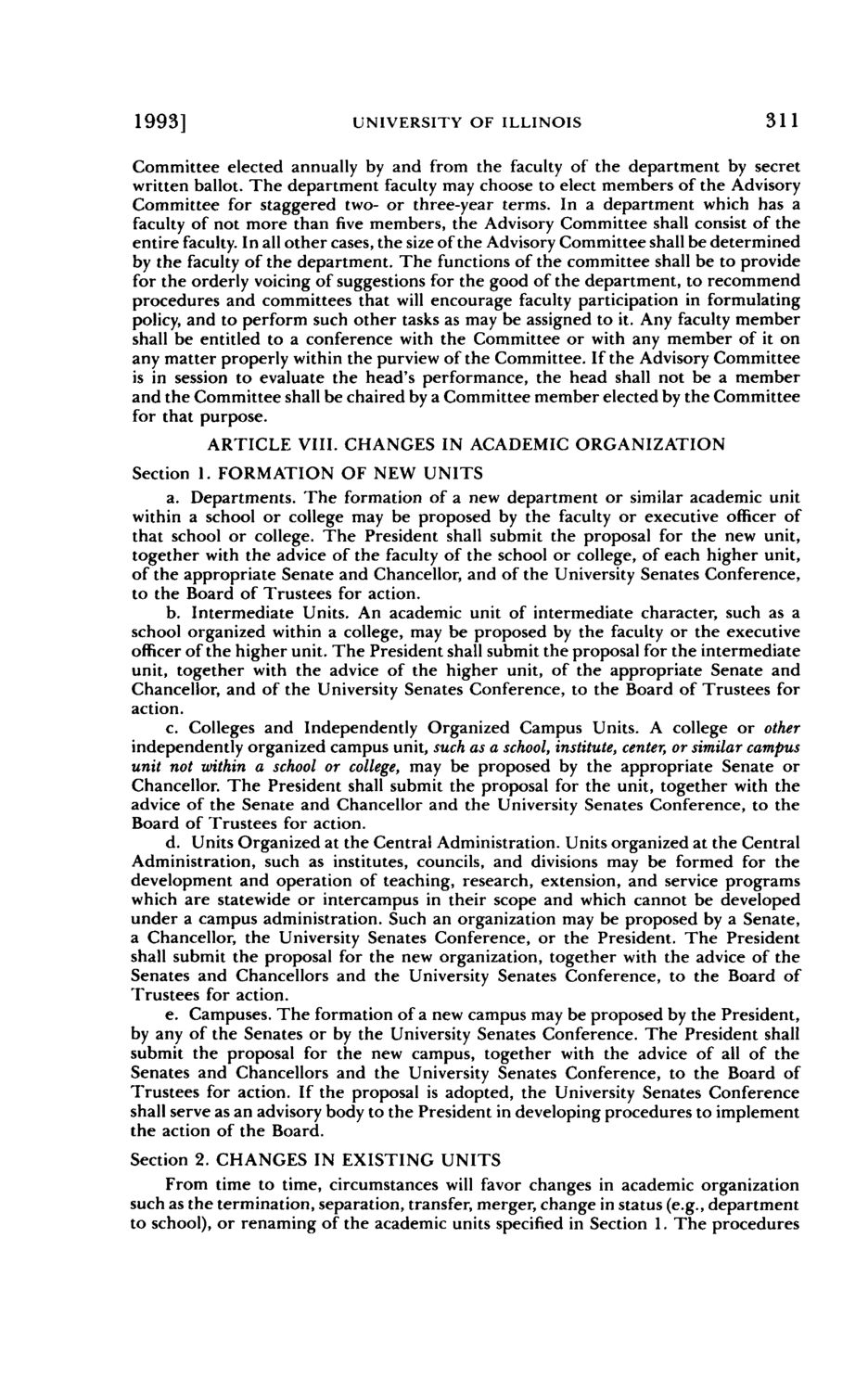| |
| |
Caption: Board of Trustees Minutes - 1992
This is a reduced-resolution page image for fast online browsing.

EXTRACTED TEXT FROM PAGE:
1993] UNIVERSITY OF ILLINOIS 311 Committee elected annually by and from the faculty of the department by secret written ballot. The department faculty may choose to elect members of the Advisory Committee for staggered two- or three-year terms. In a department which has a faculty of not more than five members, the Advisory Committee shall consist of the entire faculty. In all other cases, the size of the Advisory Committee shall be determined by the faculty of the department. The functions of the committee shall be to provide for the orderly voicing of suggestions for the good of the department, to recommend procedures and committees that will encourage faculty participation in formulating policy, and to perform such other tasks as may be assigned to it. Any faculty member shall be entitled to a conference with the Committee or with any member of it on any matter properly within the purview of the Committee. If the Advisory Committee is in session to evaluate the head's performance, the head shall not be a member and the Committee shall be chaired by a Committee member elected by the Committee for that purpose. ARTICLE VIII. CHANGES IN ACADEMIC ORGANIZATION Section 1. FORMATION OF NEW UNITS a. Departments. The formation of a new department or similar academic unit within a school or college may be proposed by the faculty or executive officer of that school or college. The President shall submit the proposal for the new unit, together with the advice of the faculty of the school or college, of each higher unit, of the appropriate Senate and Chancellor, and of the University Senates Conference, to the Board of Trustees for action. b. Intermediate Units. An academic unit of intermediate character, such as a school organized within a college, may be proposed by the faculty or the executive officer of the higher unit. The President shall submit the proposal for the intermediate unit, together with the advice of the higher unit, of the appropriate Senate and Chancellor, and of the University Senates Conference, to the Board of Trustees for action. c. Colleges and Independently Organized Campus Units. A college or other independently organized campus unit, such as a school, institute, center, or similar campus unit not within a school or college, may be proposed by the appropriate Senate or Chancellor. The President shall submit the proposal for the unit, together with the advice of the Senate and Chancellor and the University Senates Conference, to the Board of Trustees for action. d. Units Organized at the Central Administration. Units organized at the Central Administration, such as institutes, councils, and divisions may be formed for the development and operation of teaching, research, extension, and service programs which are statewide or intercampus in their scope and which cannot be developed under a campus administration. Such an organization may be proposed by a Senate, a Chancellor, the University Senates Conference, or the President. The President shall submit the proposal for the new organization, together with the advice of the Senates and Chancellors and the University Senates Conference, to the Board of Trustees for action. e. Campuses. The formation of a new campus may be proposed by the President, by any of the Senates or by the University Senates Conference. The President shall submit the proposal for the new campus, together with the advice of all of the Senates and Chancellors and the University Senates Conference, to the Board of Trustees for action. If the proposal is adopted, the University Senates Conference shall serve as an advisory body to the President in developing procedures to implement the action of the Board. Section 2. CHANGES IN EXISTING UNITS From time to time, circumstances will favor changes in academic organization such as the termination, separation, transfer, merger, change in status (e.g., department to school), or renaming of the academic units specified in Section 1. The procedures
| |